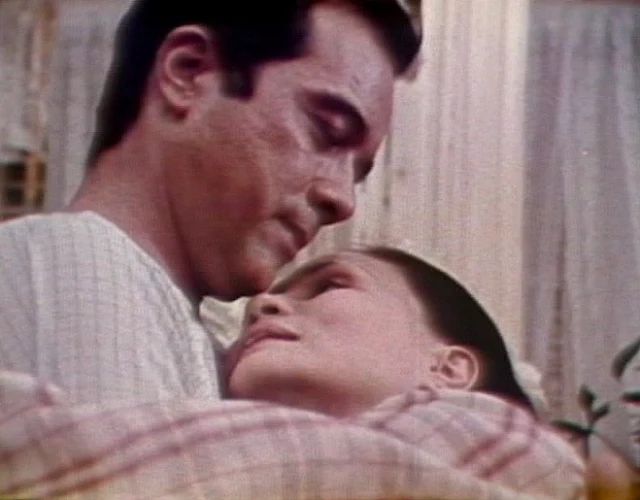
Refrains in a song
Lino Brocka's Dung-aw (Dirge, 1976), his musical adaptation of the life of Gabriela Silang is one of the less acclaimed and least seen of his films and possibly for a reason: Brocka doesn't quite have a knack for the genre. The drama swirls around this or that central figure and suddenly everyone pauses while the protagonist bursts into song; Armida Siguion-Reyna as firebrand revolutionary Gabriela Silang acquits herself well (even if you can tell she's lip-synching to a recording of her own voice) but the darkly handsome Mario Montenegro as her husband Diego (also using his own voice) can only manage a cautious warble (as he should). The result is certainly different but not the kind of inspiring historical re-enactment you (or Armida who also happens to be producer) probably had in mind.
That said Mario O'Hara's script for the film takes what little is known of Silang and fashions a brief (seventy-five minutes long) sketch of her life--her beginnings as a woman of some means (she married into wealth, married again when her first husband died), her support of second husband Diego's decision to join the British against the Spaniards in the hopes of establishing a free northern province of Ilocos, her eventual takeover of Diego's leadership role in the rebellion when he is assassinated.
Difficult to determine what's research and what guesswork, but O'Hara possibly added the detail that the Silangs often hid at least half their harvest, as the mayor (of Vigan presumably) invoking the 'indulto de comercio' (or 'license to trade') often bought their rice at artificially lowered prices then sold the grain elsewhere for a profit. Diego explains this practice to his men thusly: he's not just the owner and they the workers; everyone is in this together, the rice and profits collectively and rightfully theirs (he was an insurgent before he married Gabriela).
Despite the idealist speech O'Hara's script is hardly hagiography, nor does he portray the Silangs--especially Gabriela, especially after she takes over the rebellion--as weak-tea saints. When Gabriela confronts the man who betrayed the location of their stored rice to the mayor, she pulls out her bolo (a huge jungle sword) and whacks off his right arm (take that Joan of Arc!). Later Gabriela and her men come upon a deserted village and ask an elder what happened: the old woman tells them that the villagers have fled out of fear of her, for she is known to kill and burn down houses.
All this passes through the eyes of young Kulas (Boy Vito) who unreservedly worships Gabriela and functions as a kind of wide-eyed magnifying glass, blowing up the woman's stature to mythic proportions, the same time he functions as an uncomplaining alternative to matrimonial love (Filipino films at this time had a sophisticated attitude towards sexual fidelity apparently). At one point Kulas and Gabriela are alone together, and he listens as she shares a confidence. You wonder if this would be the youth's moment, though the camera is quick to cut discreetly away. Kulas' view of Gabriela doesn't disintegrate into disillusionment, though to be fair considering the running time there's hardly any room.
Armida isn't always well-served by her films--her high cheekbones and haughty regal demeanor usually condemn her to contrabida roles, either the tyrannical stepmother or self-righteous town official. Here she seems to be in her element, eyes flashing while waving her bolo high, same eyes melting adoring when gazing at her beloved husband. She keeps the audience mostly at arm's length, the opposite of a biopic's usual strategy, so when she suddenly confides in Kulas or suddenly runs away to be alone, the camera following closely, these moments feel genuinely intimate, bits of character reveal all the more persuasive for being unexpected.
Brocka fashions a brief vivid palimpsest on which to paint Gabriela's portrait--the beginning which recalls late Eisenstein as channeled through Welles' Othello, from dead heroine carted through the streets of Vigan to women crying mournful chorus (their darkly veiled figures looming vast in the foreground) to Gabriella's final resting site, a crude cross under a restful tree a la Gerardo de Leon's El Filibusterismo; the swearing-in ceremony with the celebrants' feeble torches meeting together under the night sky to form a blazing flame; the ending which evokes T.H. White's The Once and Future King, where a legendary blade is passed on for future generations to wield in the next revolution. If I have a consistent complaint about Brocka it's that his dramaturgy often outstrips his visual ability; with cinematographer Romy Vitug presiding over the camera there's no such problem in this film.
If we invoke the name of a Soviet filmmaker and note all the collectivist imagery in the picture that's not an accident: Brocka here (thanks partly I imagine to the fashion of '70s politics, partly to O'Hara's script) espouses an unapologetically socialist agenda, his most pointed image being of people gathered around Diego and later Gabriela while they lay out both the truth and future plans. As important if not more so than the rebel leader in these films is the leader-lecturer; the people are to have their consciousness raised, dammit, whether they want to or not.
O'Hara would in two years' time write a far more expansive film starring a far more passionate Armida and Mario, an even more lyrical Vitug lensing both. In Mga Bilanggong Birhen (The Captive Virgins, 1977) the lovers face not the relatively complacent Spaniards but ruthless implacable Americans (our history being a patchwork of foreign invaders). The lovers are married but not to each other--the prospect of extramarital love adding ardor and spice to Armida's performance, leaving her (and us to be honest) not a little breathless.
Meanwhile we have this, one of Brocka's odder more interesting works--an unjustly forgotten peek into our nearly forgotten past ornamented with music, two handsome lovers, and Vitug's memorable cinematography.
First published in Businessworld 7.15.16

No comments:
Post a Comment